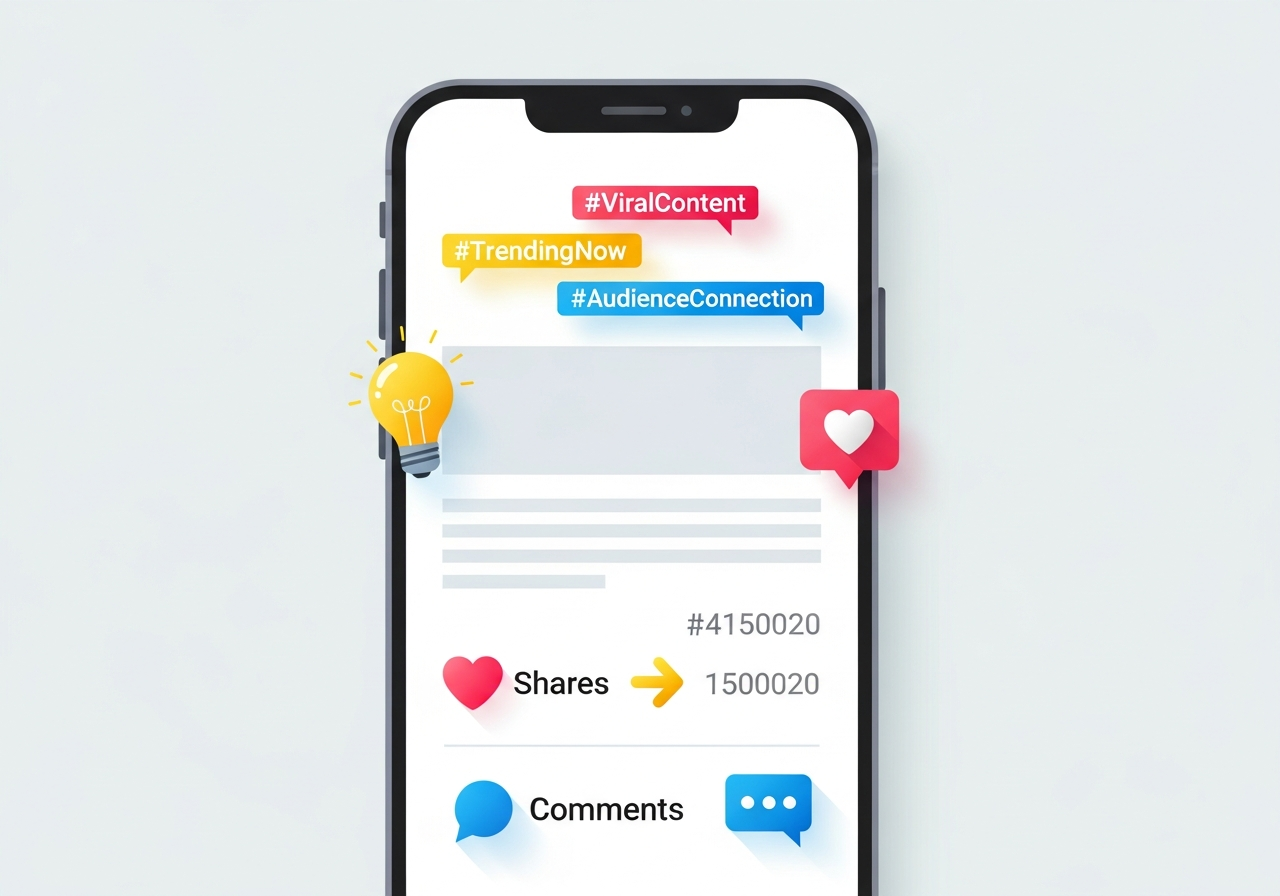
Viral content marketing creates shareable, emotionally engaging, and relevant content that spreads rapidly. Success depends on audience insight, trend awareness, compelling storytelling, authenticity, and platform optimization, driving reach, engagement, and brand growth.
Viral content marketing represents one of the most powerful yet unpredictable strategies in digital marketing. When executed successfully, it can transform a brand’s reach overnight, generating millions of views, shares, and conversations. But what exactly makes content go viral, and how can marketers harness this phenomenon?
This comprehensive guide explores the fundamentals of viral content marketing, examining the psychology behind shareable content and providing actionable strategies to increase your chances of creating viral campaigns. You’ll discover the key elements that drive virality, learn from real-world examples, and understand how to measure the impact of your viral marketing efforts.
Understanding Viral Content Marketing
Viral content marketing is a strategy that focuses on creating content designed to spread rapidly across social media platforms and digital channels through organic sharing. Unlike traditional marketing approaches that rely on paid distribution, viral content leverages the power of social networks to achieve exponential reach.
The term “viral” draws from epidemiology, describing how information spreads from person to person in a pattern similar to virus transmission. When content resonates strongly with audiences, they become willing ambassadors, sharing it with their networks and amplifying its reach far beyond the original publication.
The Mechanics of Virality
Viral content doesn’t spread randomly. It follows predictable patterns driven by human psychology and social behavior. Content typically goes viral when it triggers strong emotional responses, provides significant value, or aligns with current cultural moments.
The sharing process begins with early adopters who discover and share content within their networks. If the content resonates with these secondary audiences, they continue the sharing cycle, creating exponential growth in reach and engagement.
Platform algorithms play a crucial role in viral content distribution. Social media platforms prioritize content that generates high engagement rates, creating a feedback loop where popular content receives increased visibility, leading to more engagement and further distribution.
The Psychology Behind Viral Content
Understanding the psychological triggers that motivate sharing behavior is essential for creating viral content. Research in social psychology reveals several key motivations that drive people to share content with their networks.
Emotional Triggers

Strong emotions serve as the primary catalyst for viral content. Content that evokes powerful feelings—whether joy, surprise, anger, or inspiration—compels audiences to share their experiences with others. Positive emotions like amusement and awe tend to drive more sharing than negative emotions, though controversial content can also achieve virality through polarizing responses.
The intensity of emotional response often correlates with sharing likelihood. Content that generates moderate emotional reactions rarely achieves viral status, while content that produces strong emotional responses has significantly higher sharing potential.
Social Currency
People share content that enhances their social image or provides value to their networks. This concept, known as social currency, explains why individuals choose to associate themselves with certain content by sharing it.
Content that makes sharers appear knowledgeable, trendy, or socially conscious often performs well. Similarly, content that provides useful information, entertainment, or insights gives people reasons to share while positioning themselves as helpful resources within their networks.
Practical Value
Useful content that solves problems or provides actionable information naturally encourages sharing. When people discover valuable resources, they often share them with others who might benefit, creating organic distribution networks.
This practical value can take many forms, from educational content and how-to guides to money-saving tips and life hacks. The key is ensuring the value is immediately apparent and relevant to your target audience.
Elements of Viral Content
Successful viral content typically incorporates several key elements that increase its shareability and appeal to broad audiences.
Timing and Relevance
Content that aligns with current events, trending topics, or cultural moments has higher viral potential. This relevance creates an immediate context that audiences can relate to and discuss.
Timing extends beyond current events to include optimal posting schedules, platform-specific peak engagement times, and seasonal considerations. Content published when target audiences are most active and receptive has a better chance of gaining initial traction.
Visual Appeal
Visual elements significantly impact viral potential. Eye-catching images, compelling videos, and well-designed graphics increase engagement rates and sharing likelihood. Visual content processes faster than text, making it more suitable for social media consumption patterns.
Video content, in particular, shows strong viral potential across platforms. Short-form videos that tell complete stories or deliver quick entertainment often achieve higher engagement rates than longer content formats.
Authenticity and Relatability
Audiences respond positively to authentic content that feels genuine rather than overly promotional. Relatable content that reflects common experiences, challenges, or emotions creates stronger connections with audiences.
This authenticity doesn’t mean content should be amateurish or unprofessional. Rather, it should feel honest and human, avoiding overly polished messaging that might seem disconnected from audience experiences.
Simplicity and Clarity
Viral content typically communicates its message quickly and clearly. Complex concepts or lengthy explanations rarely achieve viral status because they require too much cognitive effort from audiences.
Simple, focused messaging that can be understood within seconds performs better than nuanced or complicated content. This simplicity extends to visual design, where clean, uncluttered layouts improve comprehension and sharing likelihood.
Strategies for Creating Viral Content
While viral success can never be guaranteed, certain approaches significantly increase your content’s sharing potential. By implementing proven viral content strategies, brands can create content that resonates emotionally, encourages participation, and spreads organically across social media platforms. These strategies include leveraging current trends, crafting emotionally compelling stories, optimizing content for each platform, and designing visually engaging, easily consumable formats. Following these methods positions your content for maximum virality while maintaining authenticity and audience relevance.

Know Your Audience Deeply
Understanding your target audience’s preferences, pain points, and behaviors forms the foundation of viral content creation. This knowledge helps you create content that resonates emotionally and provides genuine value.
Audience research should extend beyond basic demographics to include psychographic information, social media behaviors, and content consumption patterns. This deeper understanding enables more targeted content creation that speaks directly to audience interests and motivations.
Leverage Current Trends
Monitoring trending topics, hashtags, and cultural conversations provides opportunities to create timely, relevant content. However, brands should ensure their participation in trends feels natural and authentic rather than forced or opportunistic.
Trend participation works best when brands can add unique perspectives or value to existing conversations rather than simply jumping on popular topics without meaningful contribution.
Create Emotionally Compelling Stories
Storytelling remains one of the most effective methods for creating viral content. Stories that evoke strong emotions, whether through humor, inspiration, or surprise, have higher sharing potential than purely informational content.
Effective viral stories often follow familiar narrative structures while incorporating unexpected elements or emotional payoffs. Personal stories, behind-the-scenes content, and customer success stories can all serve as foundations for viral content.
Optimize for Each Platform
Different social media platforms have unique characteristics that influence viral potential. Content should be optimized for each platform’s format requirements, audience behaviors, and algorithmic preferences. Effective content optimization ensures that posts are not only visually appealing and easy to consume but also structured to maximize engagement, reach, and shareability. What works on TikTok may not succeed on LinkedIn, and content that performs well on Instagram might not resonate on Twitter—strategic content optimization helps brands adapt to these differences while increasing their chances of virality.
Measuring Viral Content Success
Defining and measuring viral content success requires establishing clear metrics and benchmarks that align with business objectives.
Engagement Metrics
Traditional engagement metrics like likes, shares, comments, and saves provide immediate indicators of content performance. However, viral content success should be measured by the rate of engagement growth rather than absolute numbers.
Viral content typically shows exponential growth patterns in engagement metrics over short timeframes. Tracking these growth rates helps identify when content is gaining viral traction and informs future content strategy decisions.
Reach and Impressions
Viral content achieves a reach that significantly exceeds normal content performance. Monitoring reach metrics helps quantify viral impact and understand how far content has spread beyond its original audiences.
Organic reach growth provides the most meaningful indicator of viral success, as it represents authentic audience interest rather than paid promotion results.
Brand Impact Metrics
Viral content should ultimately drive business results, whether through increased brand awareness, website traffic, or conversions. Measuring these downstream effects helps evaluate the true value of viral content beyond vanity metrics.
Brand mention tracking, sentiment analysis, and attribution modeling can help connect viral content performance to broader business objectives and ROI.
Challenges and Risks
Viral content marketing presents several challenges and risks that brands must consider and prepare for.
Loss of Control
Once content goes viral, brands lose control over how it’s shared, discussed, or interpreted. This loss of control can lead to unintended consequences, including negative associations or misunderstandings.
Preparing for viral success includes developing crisis communication plans and monitoring systems to track how content is being received and discussed across platforms.
Short-lived Impact
Viral content often has brief lifecycles, generating intense attention for short periods before being replaced by new trends. This ephemeral nature can limit long-term brand-building benefits.
Brands should develop strategies for capitalizing on viral moments while they occur, including follow-up content and conversion optimization tactics that transform temporary attention into lasting relationships.
Resource Allocation
Creating viral content requires significant resources without guaranteed returns. Brands must balance viral content investment with other marketing activities that provide more predictable results.
This balance involves portfolio approaches that include both viral content attempts and reliable content formats that consistently deliver steady performance.
Future of Viral Content Marketing

The viral content landscape continues evolving as platforms, algorithms, and audience behaviors change. Understanding these trends helps brands adapt their strategies for continued success.
Platform Evolution
New platforms and features regularly emerge, creating fresh opportunities for viral content. Brands that quickly adapt to new platforms and experiment with emerging formats often achieve first-mover advantages.
Algorithm changes on existing platforms also influence viral content strategies, requiring ongoing monitoring and adaptation to maintain effectiveness.
Authenticity Emphasis
Audiences increasingly value authentic, genuine content over polished, professional messaging. This trend suggests that viral content success may depend more on relatability and honesty than production quality.
Brands that embrace authenticity while maintaining professional standards are likely to achieve better viral content performance than those that prioritize perfection over genuineness.
Building Your Viral Content Strategy
Creating a successful viral content marketing strategy requires systematic planning, execution, and optimization. Start by establishing clear objectives that align with broader business goals, whether increasing brand awareness, driving website traffic, or generating leads. A useful framework to guide this process is the viral marketing funnel, which maps out the stages from initial content exposure to sharing and engagement, helping marketers identify where to optimize for maximum reach and virality.
Develop content creation processes that balance creativity with strategic thinking. This includes establishing editorial calendars that account for trending topics, seasonal opportunities, and planned campaign launches.
Invest in monitoring and analytics tools that provide real-time insights into content performance. Quick identification of viral potential enables rapid optimization and promotion that can amplify success.
Build cross-functional teams that combine creative talent with strategic thinking. Viral content often requires diverse perspectives and skills, from content creation and design to data analysis and community management.
Most importantly, maintain realistic expectations about viral content success. While viral moments can provide significant value, they should complement rather than replace comprehensive content marketing strategies that deliver consistent, measurable results.
The path to viral content success combines art and science, requiring creative vision supported by strategic planning and data-driven optimization. By understanding the psychology of sharing, implementing proven strategies, and maintaining authentic connections with audiences, brands can increase their chances of creating content that resonates, spreads, and drives meaningful business results.
FAQ: Viral Content Marketing
1. What is viral content marketing?
Viral content marketing is a strategy focused on creating content designed to spread rapidly across social media and digital channels, leveraging organic sharing to maximize reach and engagement.
2. Why does content go viral?
Content typically goes viral when it evokes strong emotions, provides practical value, enhances social image, or aligns with trending cultural moments. Emotional resonance is a primary driver of sharing behavior.
3. Can any brand create viral content?
Yes, but success isn’t guaranteed. Brands need a deep understanding of their audience, compelling storytelling, visually engaging content, and optimized platform strategies to increase virality chances.
4. Which platforms are best for viral content?
Platform choice depends on content type and audience. TikTok, Instagram, YouTube Shorts, and Twitter are highly shareable, while LinkedIn and Pinterest work well for niche professional or educational content.
5. How do I measure viral content success?
Track engagement metrics (likes, shares, comments), reach and impressions, organic growth, and brand impact metrics such as website traffic, conversions, and sentiment analysis to evaluate real value.
6. What are the risks of viral content marketing?
Viral content is unpredictable. Risks include loss of control over messaging, negative audience reactions, short-lived attention, and potential wasted resources if the content fails to resonate.
7. How can brands increase the chances of going viral?
- Understand the audience deeply
- Leverage current trends
- Create emotionally compelling stories
- Optimize content for each platform
- Maintain authenticity and relatability
8. Does high-quality production guarantee virality?
Not necessarily. While visuals matter, audiences increasingly value authenticity, relatability, and emotional connection over polished production. Content that feels genuine often spreads more effectively.
9. Can viral content lead to long-term brand growth?
Yes, when paired with follow-up strategies such as conversion optimization, lead nurturing, and consistent content marketing. Viral moments can boost awareness and engagement, feeding broader marketing goals.
10. How often should a brand attempt viral content?
There’s no set frequency. Treat viral content attempts as part of a balanced strategy, mixing high-risk viral campaigns with consistent, reliable content that ensures steady brand performance.
You can Learn about: What Is Viral Marketing? A Beginner’s Guide to Going Big











Leave a Reply